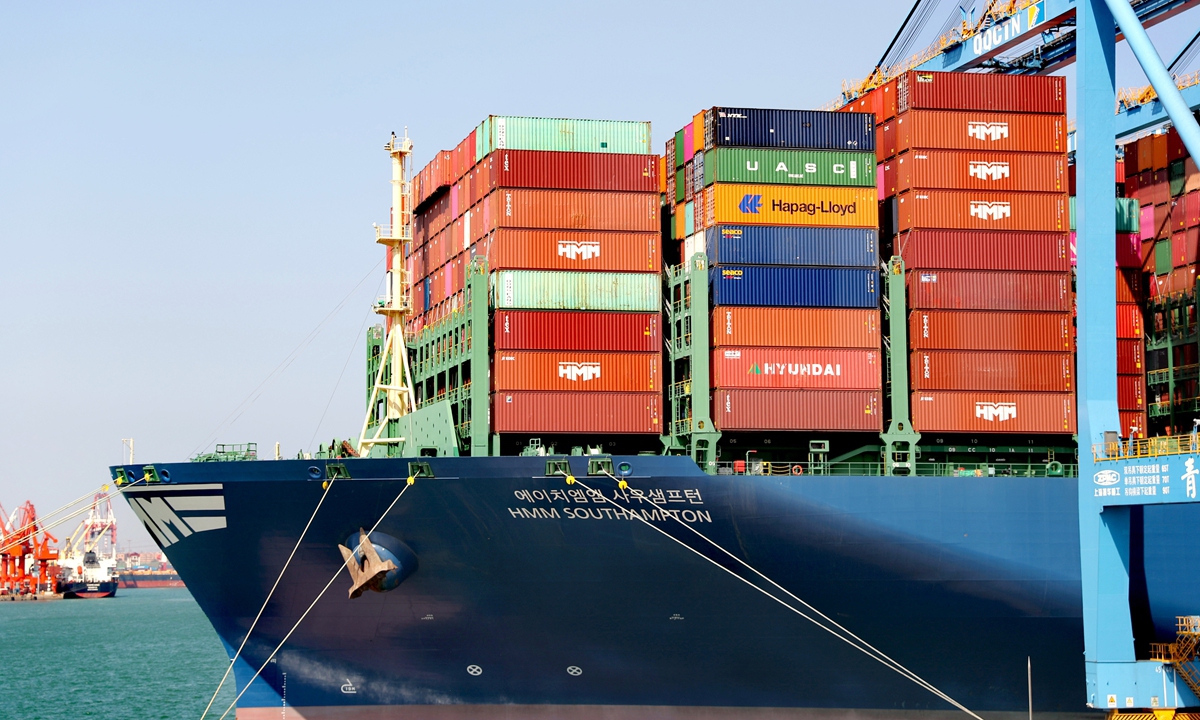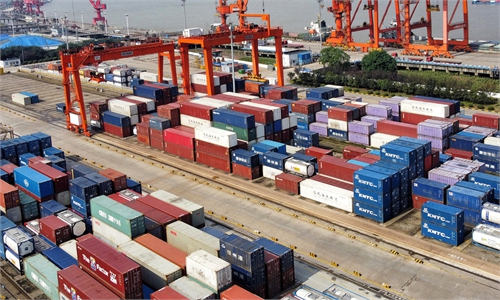
A ship loading foreign trade goods at Qingdao Port Fully Automated Container Terminal in East China's Shandong Province in early October. Photo: cnsphoto
China's imports and exports reached 31.67 trillion yuan in the first 10 months this year, an increase of 22.2 percent year-on-year and exceeding the level prior to the pandemic, rising 23.4 percent over the same period of 2019, data with China Customs on Sunday showed, despite continued Covid-19 outbreaks, logistic hurdles and a power crunch.
In dollar terms, China's total import and export value in the first 10 months of this year reached $4.89 trillion, an increase of 31.9 percent compared with the same period last year, and 30.7 percent over the corresponding period of 2019, the data from Customs said.
Among them, exports were $2.7 trillion, a year-on-year increase of 32.3 percent, while imports reached $2.19 trillion, a 31.4 percent increase year-on-year.
China's imports and exports to major trading partners such as ASEAN, the EU and the US all witnessed a significant increase in the first 10 months of 2021. Among them, ASEAN maintained the position of being China's largest trading partner, with a trade value hitting 4.55 trillion yuan, an increase of 20.4 percent.
The EU, as China's second largest trading partner, recorded a total bilateral trade value of 4.34 trillion yuan, an increase of 20.4 percent.
The increase of the trade volume between China and the US was the strongest among the top three trading partners, with the total value came to 3.95 trillion yuan, an increase of 23.4 percent.
During the same period, China's total imports and exports to countries along the "Belt and Road" nations was also very positive - reaching 9.3 trillion yuan, a 23 percent increase year-on-year.
The great jump of China's total trade has to do with the fact that Chinese supply chains continue to be among the most advanced in the world, while factories elsewhere have been disrupted by the coronavirus pandemic, Li Changan, professor of the Academy of China Open Economy Studies at the University of International Business and Economics, told the Global Times on Sunday.
This trend has enabled China to provide much-needed goods ranging from virus preventative items to home appliances that the world needed, experts said.
"China's role for being the world major goods producer will remain and the trade will be further increased during the rest of the year, to be boosted by the shopping season ahead of Christmas and the New Year," Li said.
While the total import and export value for October alone witnessed a decrease of 5.6 percent month-on-month, data with the China Customs shows, experts said that this was within expectations given the power curb in several parts of China amid high coal prices and tight supplies, as well as pandemic prevention and control measures at the borders.
The exports calculated in US dollar in October increased by 27.1 percent year-on-year to reach $300.2 billion, recording double-digit growth for a 13th consecutive month that surpassed expectations at 22.8 percent rise, media rports.
The year-on-year growth rate of imports accelerated to 20.6 percent, but it was lower than economists' expectations of 26.2 percent.
With the tight coal supplies have been largely alleviated and the number of days available for stored thermal coal has risen to 20 days at most of the power plants across the country, the energy crunch is expected to have eased for the rest of the year, experts said.
"It is expected that the growth rate of imports and exports would remain above 20 percent in November and December," Tian Yun, an economist based in Beijing, told the Global Times on Sunday.

A ship loading foreign trade goods at Qingdao Port Fully Automated Container Terminal in East China's Shandong Province in early October. Photo: cnsphoto
China's imports and exports reached 31.67 trillion yuan in the first 10 months this year, an increase of 22.2 percent year-on-year and exceeding the level prior to the pandemic, rising 23.4 percent over the same period of 2019, data with China Customs on Sunday showed, despite continued Covid-19 outbreaks, logistic hurdles and a power crunch.
In dollar terms, China's total import and export value in the first 10 months of this year reached $4.89 trillion, an increase of 31.9 percent compared with the same period last year, and 30.7 percent over the corresponding period of 2019, the data from Customs said.
Among them, exports were $2.7 trillion, a year-on-year increase of 32.3 percent, while imports reached $2.19 trillion, a 31.4 percent increase year-on-year.
China's imports and exports to major trading partners such as ASEAN, the EU and the US all witnessed a significant increase in the first 10 months of 2021. Among them, ASEAN maintained the position of being China's largest trading partner, with a trade value hitting 4.55 trillion yuan, an increase of 20.4 percent.
The EU, as China's second largest trading partner, recorded a total bilateral trade value of 4.34 trillion yuan, an increase of 20.4 percent.
The increase of the trade volume between China and the US was the strongest among the top three trading partners, with the total value came to 3.95 trillion yuan, an increase of 23.4 percent.
During the same period, China's total imports and exports to countries along the "Belt and Road" nations was also very positive - reaching 9.3 trillion yuan, a 23 percent increase year-on-year.
The great jump of China's total trade has to do with the fact that Chinese supply chains continue to be among the most advanced in the world, while factories elsewhere have been disrupted by the coronavirus pandemic, Li Changan, professor of the Academy of China Open Economy Studies at the University of International Business and Economics, told the Global Times on Sunday.
This trend has enabled China to provide much-needed goods ranging from virus preventative items to home appliances that the world needed, experts said.
"China's role for being the world major goods producer will remain and the trade will be further increased during the rest of the year, to be boosted by the shopping season ahead of Christmas and the New Year," Li said.
While the total import and export value for October alone witnessed a decrease of 5.6 percent month-on-month, data with the China Customs shows, experts said that this was within expectations given the power curb in several parts of China amid high coal prices and tight supplies, as well as pandemic prevention and control measures at the borders.
The exports calculated in US dollar in October increased by 27.1 percent year-on-year to reach $300.2 billion, recording double-digit growth for a 13th consecutive month that surpassed expectations at 22.8 percent rise, media rports.
The year-on-year growth rate of imports accelerated to 20.6 percent, but it was lower than economists' expectations of 26.2 percent.
With the tight coal supplies have been largely alleviated and the number of days available for stored thermal coal has risen to 20 days at most of the power plants across the country, the energy crunch is expected to have eased for the rest of the year, experts said.
"It is expected that the growth rate of imports and exports would remain above 20 percent in November and December," Tian Yun, an economist based in Beijing, told the Global Times on Sunday.

